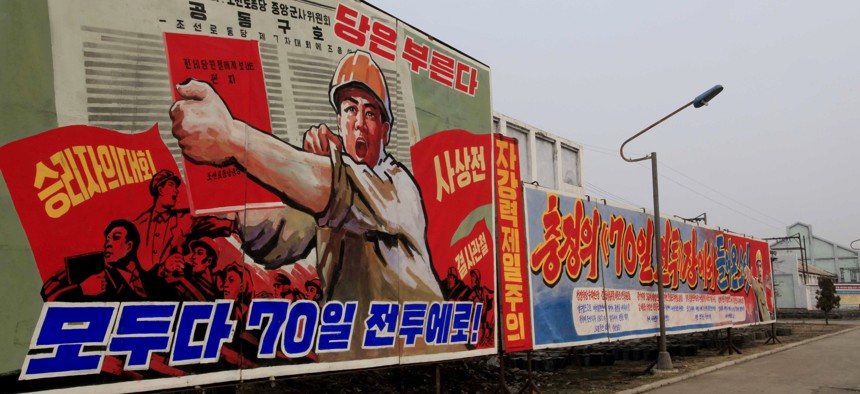
This North Korean propaganda billboard reads: "Party is calling. Everybody to the 70-day campaign." Kim Kwang Hyon/AP
CIA Opens a New Office To Watch North Korea
The first “mission center” launched since the spy agency’s 2015 reorganization, it is also the most narrowly focused.
Two years after the CIA reorganized itself to create 10 “mission centers,” the spy agency is adding a new one devoted specifically to North Korea.
Then-director John Brennan launched that 2015 restructuring — it also created the Directorate for Digital Innovation, the agency’s first new directorate in half a century — to modernize the agency and eliminate stovepipes between its analysts, agents, and hackers. Instead of offices built around kinds of expertise, the new mission centers house cross-functional teams focusing on a threat or a region. That allows them to “harness the full range of CIA’s operational, analytic, support, technical and digital capabilities,” the CIA said in a Facebook post.
The new Korea Mission Center at CIA headquarters in Virginia is intended to do the same thing for a country that at least one intelligence expert calls “the hardest of hard targets.”
In a press release, CIA Director Mike Pompeo said the new center “allows us to more purposefully integrate and direct CIA efforts against the serious threats to the United States and its allies emanating from North Korea.”
Pompeo also said the move reflects the CIA’s agility. Keeping the organizational chart malleable and adding the new center is part of the agency’s efforts to stay responsive as national security threats evolve and priorities shift.
When Brennan created the mission center structure, it “involved an arbitrary way of splitting up the world” that could later be tweaked, according to Paul Pillar, the former National Intelligence Officer for the Near East and South Asia. “I think the expectation always was that there might be some shifting of where the geographic lines were drawn to reflect changes in priorities given to particular countries or areas.”
The new center will join a mission center for East Asia and the Pacific (six of the existing 10 centers focus on geographic regions; the other four are functional). This will be the most geographically narrow center.
“Interestingly, I don't see one specifically for China or Russia,” said Bruce Klingner, a Heritage Foundation senior research fellow on northeast Asia who has worked for the CIA and the Defense Intelligence Agency. Otherwise, Klingner said, it’s “a pretty straightforward announcement of a response to the growing North Korean danger, particularly as it gets closer to a nuclear ICBM capability.”
Leaving office, President Barack Obama reportedly warned Donald Trump that North Korea would be his most urgent problem, and the new president has largely treated it as such. Trump’s administration has had an unflagging focus — if occasionally scattered message — on the regime in Pyongyang. Visiting the peninsula last month, Vice President Mike Pence announced that “the era of strategic patience is over.”
“The administration has made it very clear that in the early days of this administration, Korea is a particular priority,” RAND Corporation analyst Bruce Bennett said. “This is a time where the administration’s not saying ‘We’d like a broad view of Europe or Central Asia.’ They’re saying we have a very particular problem here.’”
That focus has contributed to a ratcheting up of tensions between the U.S. and North Korea over the past two months, which has included all the usual moves on the Pacific chessboard: from Korean missile tests and military parades to patrolling U.S. aircraft carriers and discussions with China. The latest: The U.S. House of Representatives voted to tighten sanctions on North Korea, and Pyongyang responded with a rare letter warning that would only encourage its nuclear weapons development.
“The U.S. has always done a lot of work on North Korea, but we’re now at a point in time where being more effective at it is key, because the threat is developing in key ways,” Bennett said. “If North Korea really has 30 or 40 nuclear weapons … with a leader who is paranoid, that’s something that we really need to be on top of.”




